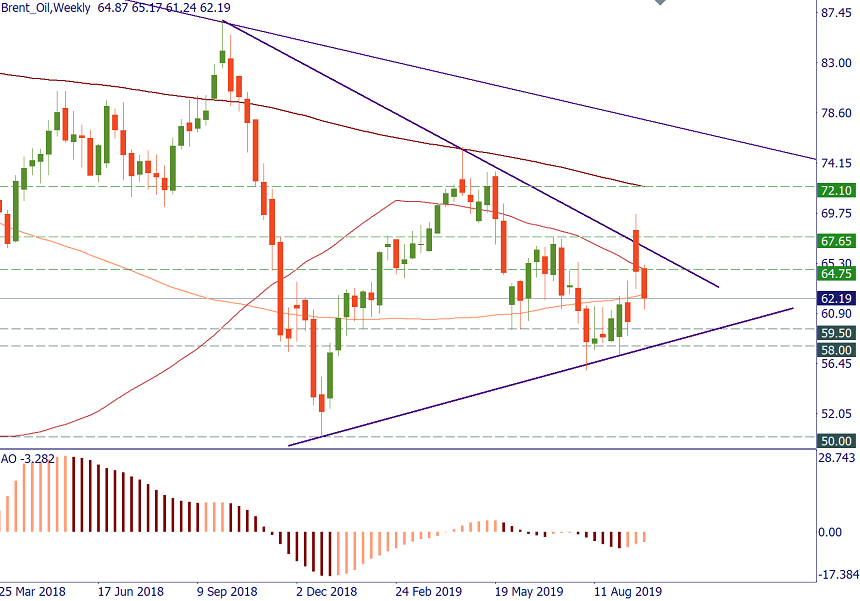
Dua tahun ini, kita menyaksikan pergerakan harga minyak terbesar dalam tempoh 14 tahun, yang membingungkan pasaran, pelabur dan pedagang akibat ketegangan geopolitik dan peralihan ke tenaga bersih.
2019-11-14 • Dikemaskini
Oil prices have been very volatile during the past few weeks. There’s nothing surprising about that: geopolitical tensions, trade wars, and economic releases have been shaking the commodity market. What’s next for oil? In this article, we try to analyze various fundamental factors to answer this question.
Supply: still high
A big bullish gap appeared on the charts of Brent and WTI on September 16 as a drone attack on Saudi oil facility removed nearly 5% of global crude supplies. Naturally, lower supply pushed the price upward: the limited resource always costs more.
At the same time, Bloomberg reported on Thursday, citing sources familiar with the matter, that Saudi Arabia has boosted total production capacity to more than 11 million barrels a day. That means that the country’s oil industry is recovering from the shock quicker than expected. Of course, things in the region are pretty unstable and no one can exclude the possibility of new strikes. Yet, the restoration of supply will make investors calm down a bit. This is good news for oil sellers and bad news for buyers: bigger supply will pull prices down. Moreover, on Monday, Iran released the detained British oil tanker, which had been held since July. This should also help to soften tensions a bit.
Be aware that not only Saudi Arabia is flooding the world with oil. According to the Energy Information Administration, American crude oil inventories for the week to September 20 increased by 2.4 million barrels after rising by 1.1 million the week before that. All in all, there’s plenty of oil out there, a factor which is negative for the commodity’s price.
Demand: still low
The key factor for the demand is the trade war between the United States and China. The situation changes almost daily as we get new comments and statements from various policymakers. At the beginning of September, trade tensions sharply escalated. By the end of the month, however, investors have become more optimistic on the news that trade talks will resume at the beginning of October. China’s purchases of US products (pork, beef) also helped to break the ice.
Opinions about what’s going to happen next differ greatly. Experience shows that the general uncertainty may drag on and on with periods of cheerful optimism followed by vicious pessimism attacks. What matters is that, according to Citigroup, the US-Sino trade war has already almost halved oil demand growth reducing consumption growth by 800,000 barrels a day since the end of March 2018. If the trade conflict continues for six more months, the figure will lose another 300,000 barrels. The conclusion is simple: fewer buyers, cheaper oil.
Summary
The chart shows that Brent has been consolidating within a wide triangle since the start of the year. The technical picture reflects the fundamental one: the market is swinging up and down on the contradictory news about trade wars but is not able to start a big new trend. The problem is that there’s still hope of a trade deal but the market's desire to see the United States and China reconcile remains unfulfilled. During the next couple of weeks, the expectations of the upcoming talks should keep the price supported, although with all the abundant supply we can’t expect any sizeable recovery. Then the lack of good news may move Brent and WTI down. The big breakthrough to the upside will be possible only if America and China start canceling their mutual tariffs.
For the near term, support for Brent lies at 59.50 (June lows) and 58.00 (support line connecting the 2018 and 2019 lows), while resistance is at 64.75 (50-week MA) and 67.65 (July highs).

Notice that to trade Brent, you need to choose CFD futures in your MetaTrader.

Dua tahun ini, kita menyaksikan pergerakan harga minyak terbesar dalam tempoh 14 tahun, yang membingungkan pasaran, pelabur dan pedagang akibat ketegangan geopolitik dan peralihan ke tenaga bersih.

Selepas beberapa bulan menerima tekanan dari Rumah Putih, Arab Saudi mengalah dan bersetuju untuk meningkatkan pengeluaran bersama dengan ahli-ahli OPEC+ yang lain.

Pada hari Khamis, 2 Jun, Pertubuhan Negara-Negara Pengeksport Petroleum Plus (OPEC+) telah bersetuju untuk meningkatkan pengeluaran sebanyak 648,000 tong sehari (bpd) pada bulan Julai dan Ogos.

Fed mengumumkan pada hari Rabu bahawa ia membiarkan kadar dasar tidak berubah pada 5…

Jepun melangkah lebih dekat kepada campur tangan mata wang dengan amaran terkuatnya apabila yen merosot ke paras paling lemah dalam kira-kira 34 tahun berbanding dolar…

Sentimen pasaran yang memulih pada pembukaan dagangan awal minggu semalam telah menukar semula haluan pergerakan USD…
FBS menyimpan rekod data anda untuk mengoperasikan laman web ini. Dengan menekan butang "Terima", anda menyetujui Polisi Privasi kami.
Permohonan anda telah diterima
Pengurus akan menghubungi anda dalam amsa terdekat
Permohonan panggil balik seterusnya untuk nombor telefon ini
boleh dilakukan dalam dalam
Jika anda mempunyai isu yang perlu disegerakan, sila hubungi kami menerusi
Live Chat
Masalah dalaman. Sila cuba sebentar lagi
Jangan bazir masa anda – pantau bagaimana NFP mempengaruhi dolar AS dan kaut keuntungan!
